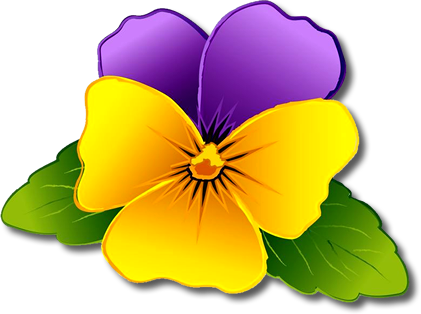
13 Woodlanders Online Nursery
September 18, 2020
15 San Antonio Botanical Garden
October 16, 2020LEFT: Pennisetum orientale (Oriental Fountain Grass), Bouteloua gracilis 'Blond Ambition' (Blue Grama), Chasmanthium latifolium (Northern Sea Oats), Imperata cylindrica (Japanese Blood Grass). RIGHT: Bouteloua gracilis 'Blond Ambition' (Blue Grama), Muhlenbergia capillaris (Pink Muhly), Miscanthus sinensis var. condensatus 'Cosmopolitan' (Eulalia, Japanese Silver Grass). CONTAINER: Pennisetum setaceum 'Rubrum' (Purple Fountain Grass).
Ornamental Grasses
A s for the shear beauty and magic of ornamental grasses in the garden, the photo above of the Sherwood Demonstration Garden's 6-year-old Ornamental Grass Garden speaks for itself!
Ornamental grasses are low maintenance and low-water usage. And as you can see, they bring amazing variety of color, size, shape and contrast to the garden.
If you are one of those who don't like ornamental grasses, I have to ask, "Are you somehow impaired?!"
Grasses are about as low maintenance as you can get. They require only a once-a-year cut back to the ground. (I generally cut mine around the first of February.) And I don't mean cut back to 1 foot or 2 feet, but ALL the way to the ground. Quick and easy. Evergreen types such as Carex, Festuca, Lomandra, or Rush do not need cutting back at all unless they have been damaged by people, animals or weather.
Most grasses are low-water usage plants. Even medium-water grasses can be stressed down to low-water. I do this by putting low and medium on the same irrigation valve/station. (I do this throughout all my gardens with various types of plants, but I do not stress a high to low. I’m not that mean!)
As for variety, you will find blue grasses, purple grasses, bronze, green, variegated, chartreuse—the list goes on and on.

Schizachyrium scoparium ‘Little Bluestem’
Schizachyrium scoparium ‘Little Bluestem’ is an evergreen grass, but if damaged by winter freeze you just whack it down and it will grow back. It grows to 3 feet tall and 1 wide, has fluffy, delicate bluish purplish blades which provide some softness against other more erect grasses.
Two years ago I installed three 1-gallon 'Little Bluestems' but apparently it reseeds because now I have 4 others growing within my Fall Garden (which is not ready to share with you yet!).
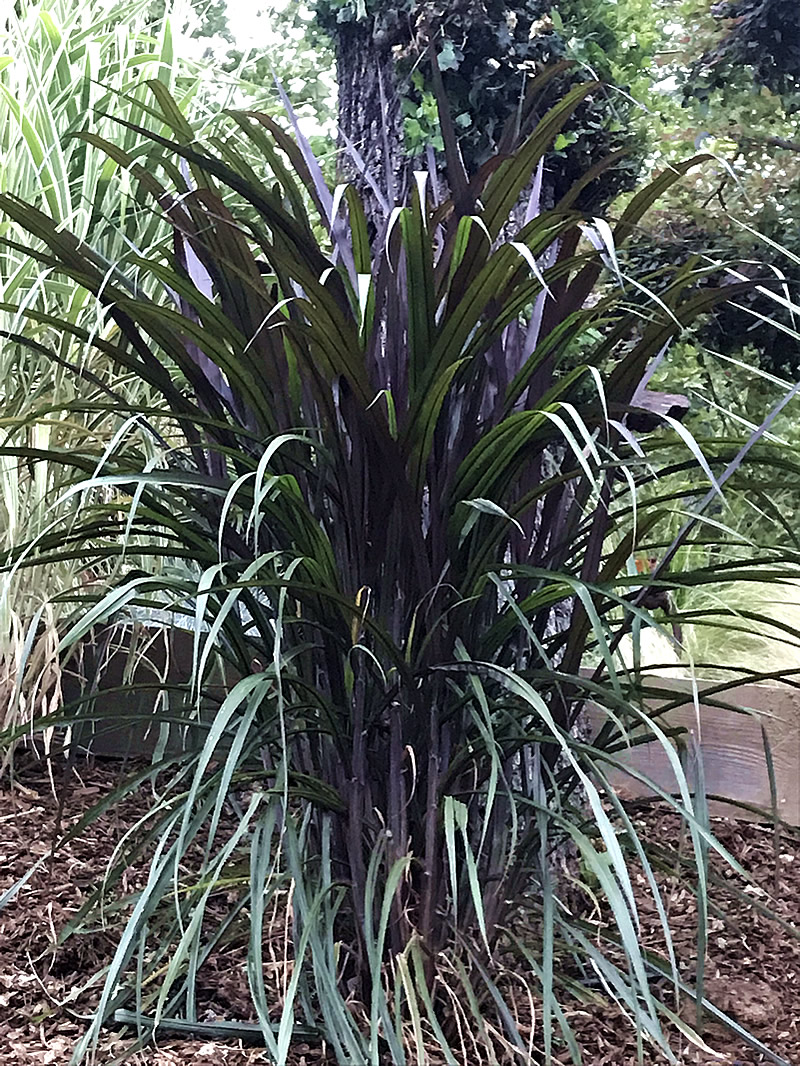
My Pennisetum 'Princess Caroline' in June, 2019.
I remember the day I first stumbled upon Pennisetum 'Princess Caroline' in a local nursery (now closed). It was March 2019 and the day was cold and windy—which I love because I can sweat even in snow. Chilly weather, me comfortable in shorts and t-shirt AND shopping at a nursery: in my garden bible, a perfect day. And there was Princess Caroline! A couple of striking purple blades and a root ball just bulging out of its 4-inch pot. It said to me "take me, take me!" So I did. For $3.99.
I had tried to grow a Pennisetum ‘First Knight’ that I bought from my online supplier, Woodlanders, but it died. I tried again, and, yup....dead again! The micro-climate at my place might be too cold in winter for Pennisetums to survive, I thought. So I planted little Ms. Princess directly in the ground, and she grew like crazy all that year. Instead of cutting her to the ground in February 2020, I kept the old growth through to the first of May and then whacked it back. And she lives!!!
Here's a different Pennisetum in a landscape I installed for my client, Isabel, in July 2019. (She took this picture for me. Thank you!)
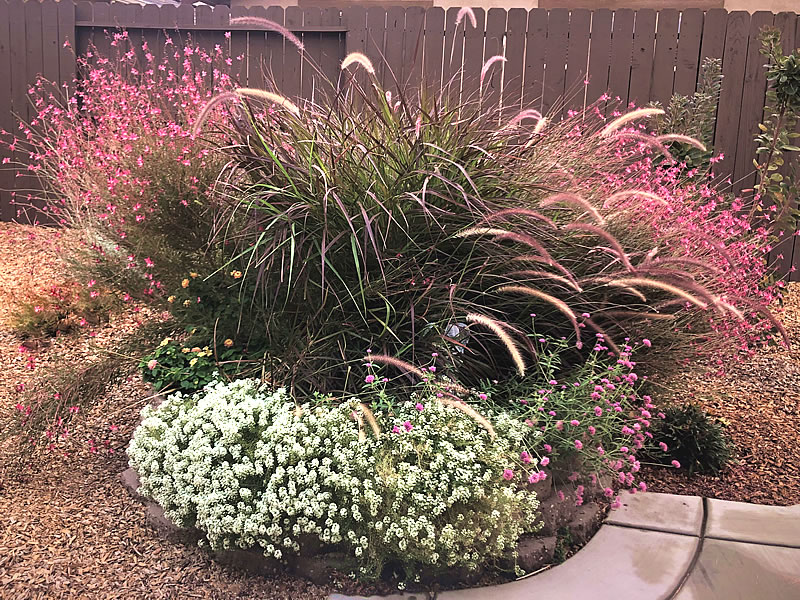
Pennisetum setaceum 'Rubrum' (Purple Fountain Grass), Gaura lindheimeri ‘Belleza’, Lantana camara ‘Pink Caprice’,
Gomphrena ‘Pink Zazzle’, Lobularia maritima (Sweet Alyssum)
Wow, right? The Pennisetum setaceum 'Rubrum' (Purple Fountain Grass) knows how to bring the drama!
Believe me, it does not take much effort (well...no tears or blood...) or much money to have beauty like this in your garden. And all using what I call common plants because they are easily available at any nursery.
Now here's a grass that is not everyone's cup of tea because it tends to look a little...well, dead. But it's not.

That's Carex buchanaii ‘Red Rooster’ (Red Rooster Sedge) to the right of my grandson who is playing in the drinking fountain, and Yucca ‘Bright Star’ to the left—another all time favorite. (Notice how I have a lot of favorites?!)
That 'Red Rooster' may look dead because it’s not green but reddish bronze ('Red Rooster,' get it?). It grows erect and then eventually weeps at maturity. This is a fabulous grass for containers for height and texture and for something besides green. It's an evergreen grass so no yearly whacking required. Though I did an experiment with one and cut it back because it was actually looking dead! (YES I do know the difference!) It grew back but slowly.
Recently I installed my first ever succulent garden (finally!...and soon to be on my business website) which turned out stunning. I mean really gorgeous. I mixed in 'Red Rooster' with the succulents, but the customer called me within a week and told me to "come take out the dead plant." I tried to convince her to give some time for the colors of 'Red Rooster' to intermingle and play off the succulent colors. She wasn't having it. So I gave it a home at the Sherwood Demonstration Garden’s Rock Garden.
Now for my all time favorite ornamental grass: Miscanthus sinensis 'Gracilimus' (Maiden Grass).
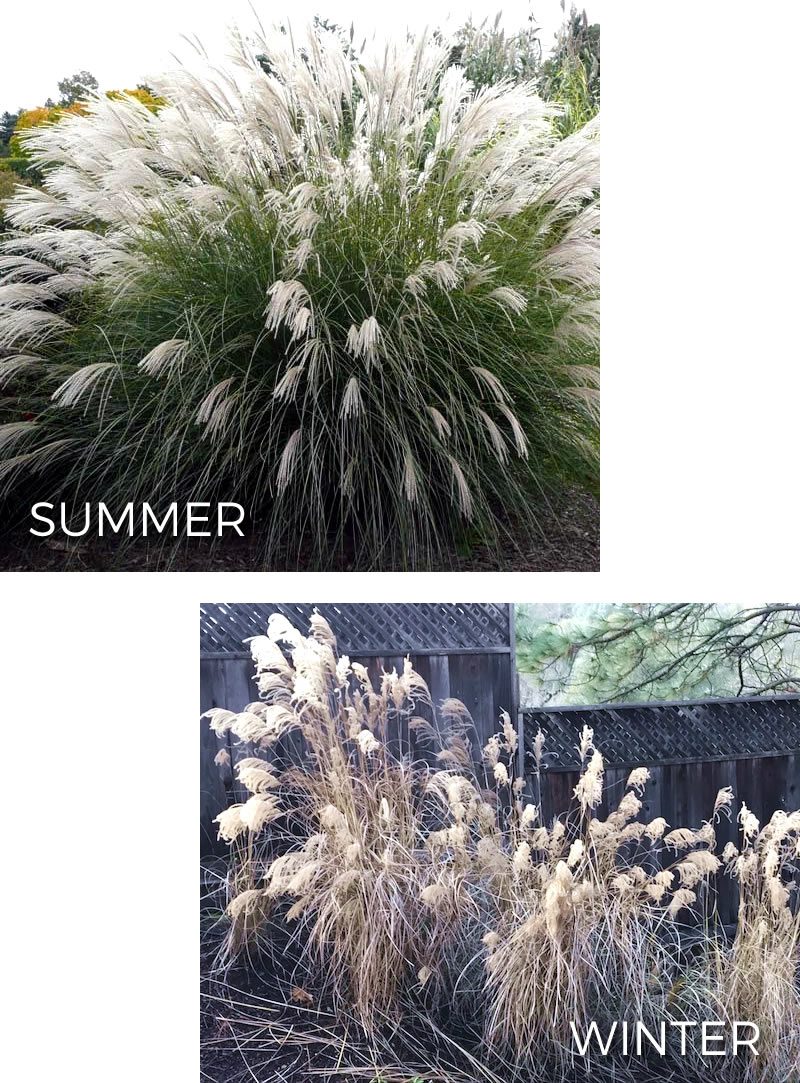
Need I say more. I mean really. NEED I SAY MORE?!
Now meet Godzilla!
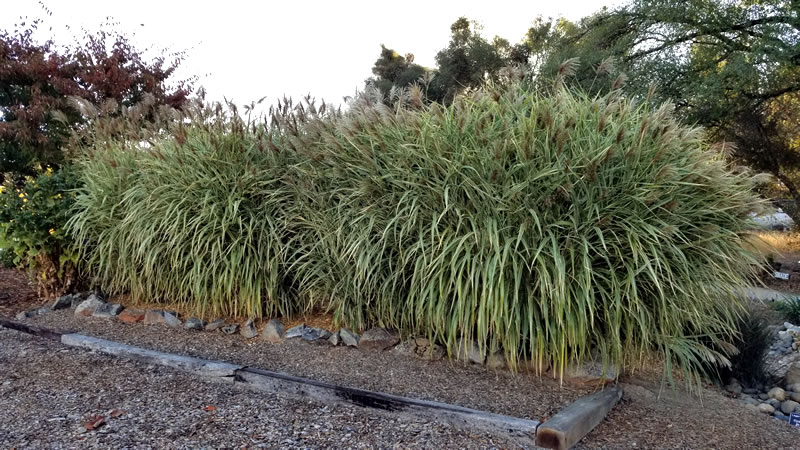
Miscanthus sinensis var. condensatus 'Cosmopolitan' (Eulalia, Japanese Silver Grass) can grow 8 to 10 feet tall and 4 feet wide.
Here it is at the Sherwood Demonstration Garden's Ornamental Grass Garden.
I installed 7 of these Godzillas along a decomposed granite walkway sloping down through my gardens and ending at the pool.
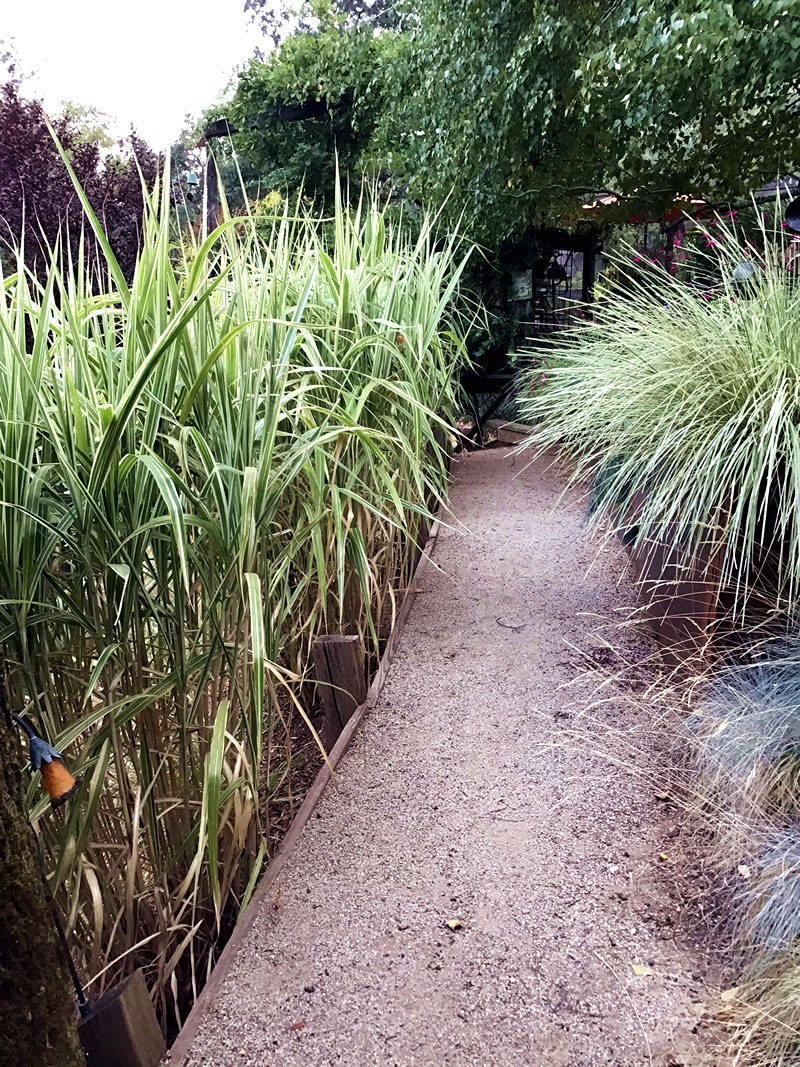
There's only one thing I don’t like.
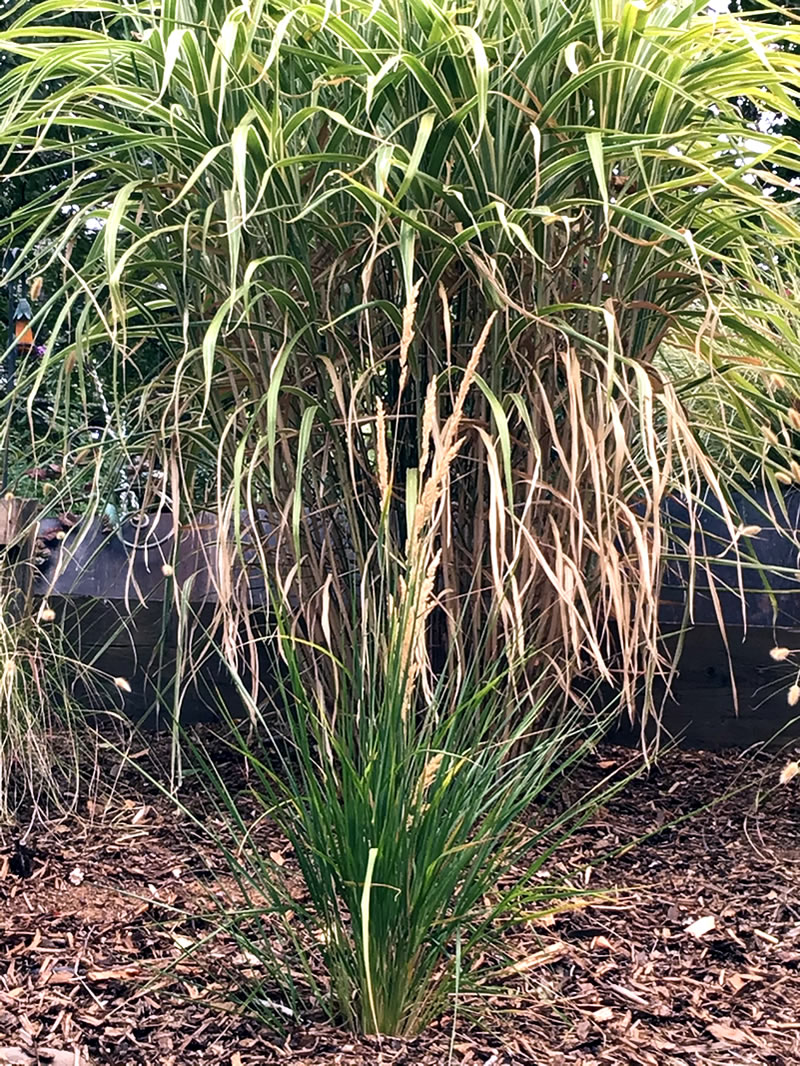
Starting around mid-September the bottom fourth of the plant turns brownish. So I have placed Calamagrostis acutiflora ‘Karl Foerster’ (Reed Grass) in front of the entire row of Godzillas as viewed from the pool. I planted Mr. Foerster just this spring and, by summer 2021, it will completely hide Godzilla's brownish habit.
And finally...
Fifteen years ago, I planted three 1-gallon pots of Hackonechloa macra ‘All Gold’ surrounding a Helleborus x hybridus ‘Sparkling Diamond.'
Here are the results:
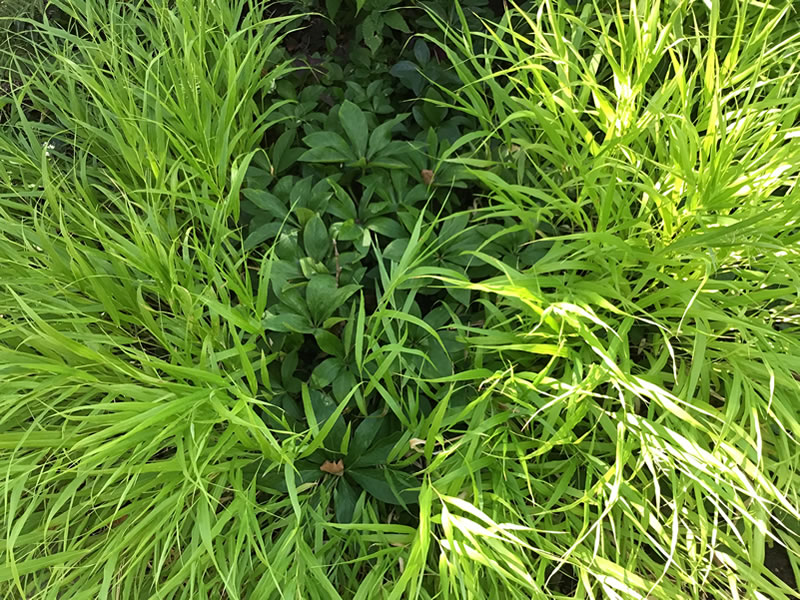
'Sparkling Diamond' is not in bloom here, but this is a good example of how I design in 3-by-3-foot spaces. I make sure one space is as beautiful as possible before starting the next space, and so on. This way you don't walk out the door to work on building or renovating your garden and immediately hear "squirrel!" because you are distractedly trying to envision and work on an entire garden all at once. You might not make it back to that "I'll-finish-this-later" space, so make it completely beautiful now before moving on. You will enjoy having one space that is NOT in-progress. And that means 3 by 3 less stress!
And for heaven's sake some of you, get off your anti-ornamental-grass high horse! If you're reading Miss Viola, you surely have a smidgeon of sanity.
Photos courtesy Sheri Lynn Burke. All rights reserved.
Courtesy photo by Sue McDavid.

